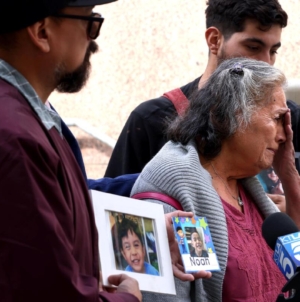-
Trump Said to Demand Justice Dept. Pay Him $230 Million for Past Cases - 20 mins ago
-
What Resolution’s Investor Strategy Tells Us About Corporate Climate Action - 21 mins ago
-
Pilots on an LAX-bound flight thought people were trying to breach the cabin and declared an emergency - 44 mins ago
-
Warnings issued for nearly entire US West Coast - 55 mins ago
-
Louvre Robbery Raises Questions About Security - about 1 hour ago
-
Federal immigration agent hospitalized after shooting in South Los Angeles - about 1 hour ago
-
NFL Insider Makes Bold Claim on Sam Darnold’s Success With Seahawks - 2 hours ago
-
North Carolina Senate Approves New Map in Effort to Add G.O.P. Congressional Seat - 2 hours ago
-
Gen Z Couple Buy Home, No One Prepared for Who Man Dedicates Key Room To - 2 hours ago
-
L.A. car chase suspect run over by multiple vehicles on live TV - 2 hours ago
More rain could be on the way this week to Southern California

Parts of the Los Angeles region could see light rain this week as a small chance of thunderstorms brings the possibility of more precipitation following last week’s soaking, according to the National Weather Service.
There is a 10% chance of rainfall across Los Angeles County on Tuesday night, but that chance of showers drops to as low as 5% going into Wednesday, said Carol Smith, a National Weather Service meteorologist in Onxard.
Interior valleys and mountain areas of the Southland are most likely to see rain, she said, with a slight chance of precipitation in the valleys and along the coast.
Conditions will not come close to the intense showers and winds Los Angeles County experienced last week.
There is, however, a slight chance of thunderstorms, particularly over the mountain areas of Ventura and Santa Barbara counties, which could carry over into Los Angeles County near the Grapevine area of the 5 Freeway, Smith said.
Those areas could see some isolated dry lightning during the storm. The weather phenomenon occurs when there is dry air near the ground during a thunderstorm and can bring a risk of fire.
“Any part of a thunderstorm has updrafts and downdrafts, and you get these downdrafts with rain if there’s enough moisture,” Smith said. “But if you don’t have very much moisture and really dry air in the lower levels of the atmosphere, it just evaporates.”
That leads to virga, which is rain that appears to be dropping from a cloud but evaporates before it reaches the ground. If virga occurs along with dry lightning, there is a risk of fires being sparked, she said. Smith reiterated, however, that the chance of dry lightning was low. Also, experts say that last week’s rain tamped down the threat of fire, at least temporarily.
The potential midweek moisture likely won’t alter the dry conditions meteorologists are predicting for the coming winter months, Smith said.
At the start of October, the National Oceanic and Atmospheric Administration announced that La Niña conditions had officially returned. The climate pattern typically drives drought conditions in Southern California.
Meteorologists say the previous La Niña, which extended from January until about April, played a significant role in the region’s dry winter, fueling the fires that devastated the Palisades and Altadena communities.
As La Niña returns, Southern California continues to be at a relatively high risk for fire and severe drought, according to the U.S. Drought Monitor.
Last week, an atmospheric river storm hit Los Angeles with scattered downpours, fears of flooding and powerful winds.
Evacuation warnings were issued in areas affected by January’s wildfires — including the burn scars from the Palisades fire, the Eaton fire in Altadena, the Hurst fire in Sylmar and the Sunset fire in the Hollywood Hills.
Last week’s storm dumped about 2.17 inches of rain in Bel-Air, 2.10 inches in Beverly Hills, 1.27 inches in downtown Los Angeles and 3.28 inches in Woodland Hills. The last time downtown got more than an inch of rain in a single day in October was 2009, said John Dumas, a meteorologist with the National Weather Service in Oxnard.
The storm also brought enough moisture to Southern California’s drought-stricken landscape to delay fire season for weeks, if not months, according to Marty Ralph, director of the Center for Western Weather and Water Extremes at UC San Diego’s Scripps Institution of Oceanography.
Source link














